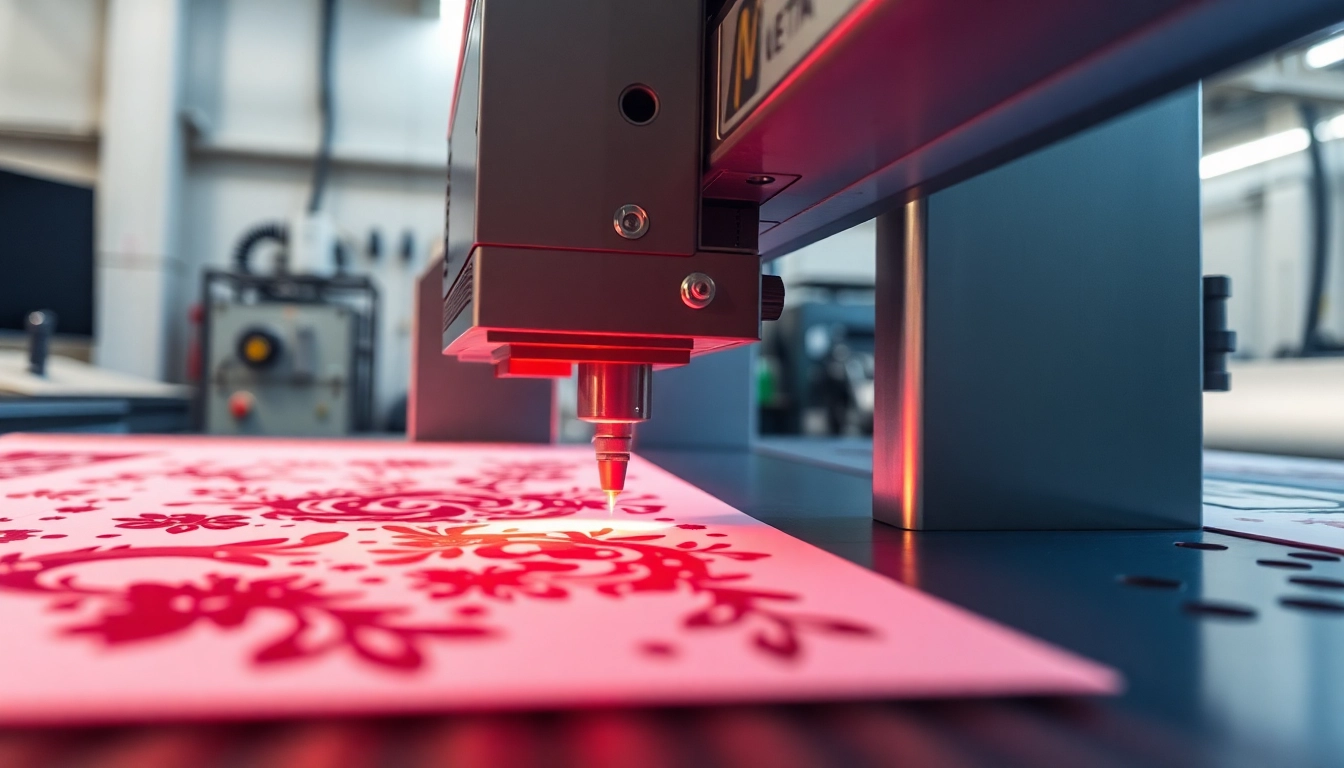Understanding Precision Die Cutting
What is Precision Die Cutting?
Precision die cutting is a manufacturing process used to create various products, components, and parts by cutting materials into specific shapes and sizes with high accuracy. This technique employs a steel rule die or a rotary die to cut through materials, allowing for the creation of complex shapes and designs with exceptional uniformity and precision. The term ‘precision’ signifies the extreme control over tolerances achievable in this process, often within +/-0.005 inches, which makes it indispensable in industries requiring detailed specifications.
This capability is critical for applications demanding consistency and repeatability, such as automotive, aerospace, electronics, medical devices, and packaging. Notably, the precision die cutting process transforms raw materials—ranging from paper and plastics to metals and composites—into custom solutions tailored to specific operational needs.
Benefits of Precision Die Cutting in Manufacturing
Precision die cutting offers numerous benefits that enhance manufacturing efficiency and product quality. Below are some key advantages:
- High Accuracy: The precision offered allows manufacturers to produce parts that meet extremely tight tolerances, essential for industries like aerospace and healthcare.
- Cost-Effectiveness: Although the initial setup cost can be high, the efficiency gained in production can significantly reduce the cost per unit over time—particularly for large runs.
- Material Versatility: Precision die cutting can be performed on a wide array of materials, including paper, plastics, metals, and foam, which allows manufacturers to meet diverse customer needs.
- Reduced Waste: The process minimizes scrap material through precise cut patterns, leading to a more sustainable manufacturing approach.
- Quick Turnaround: Once the die is set up, producing parts can be a rapid process, allowing companies to meet tight delivery schedules.
Common Applications in Various Industries
The applications of precision die cutting span numerous industries, each utilizing the technology for bespoke components:
- Automotive: Precision die cutting is used for gaskets, seals, insulation, and various interior components that require tight tolerances.
- Medical: Components like surgical masks, adhesive bandages, and diagnostic kits rely on die cutting to ensure accuracy and safety in the products.
- Electronics: The manufacturing of circuit boards, insulation, and cushioning materials for sensitive components often employs die cutting techniques.
- Packaging: Custom packaging solutions benefit from die cutting to create boxes, inserts, and labels with high precision and aesthetic appeal.
- Textiles: Fabrics are often die cut into specific shapes for garments, upholstery, and various industrial applications.
Types of Die Cutting Techniques
Rotary Die Cutting Explained
Rotary die cutting involves a cylindrical die that cuts materials as they are fed through the machine. This technique is particularly advantageous for long production runs as it allows for continuous cutting. The robustness of the rotary die means it can cut complex shapes with speed and precision, making it ideal for applications where high volume is needed without sacrificing quality.
This method is often used in the manufacture of pressure-sensitive labels, packaging materials, and gaskets. Its efficiency in cutting allowed JBC, for example, to establish itself as a leader in flexible material die cutting, as they can quickly pivot to produce varied custom parts based on market demand.
Flatbed Die Cutting: Pros and Cons
Flatbed die cutting uses a flat surface where the material is pressed against a die to achieve the cut. While it allows for the use of steel-rule dies that are ideal for lower volume production and complex shapes, flatbed die cutting has both advantages and disadvantages:
Pros:
- Flexibility in design, allowing for unique shapes and sizes.
- Lower initial costs for small production runs.
Cons:
- Slower than rotary die cutting for high volumes.
- Potentially higher levels of waste and less material utilization.
Laser Cutting vs. Traditional Die Cutting Techniques
Laser cutting has emerged as a competitor to traditional die cutting techniques. It uses focused laser beams to vaporize material, allowing for intricate designs and detailed cuts. While laser cutting offers benefits, such as no tool wear and customizable outputs on the fly, it is typically slower than die cutting for large production jobs.
Moreover, laser cutting excels in precision and the ability to handle a variety of materials, including brittle and sensitive items. However, the cost per cut may be higher compared to die cutting when produced at scale. Each method has its place, and businesses must consider factors such as production volume, material type, and end-use when deciding between traditional die cutting and laser cutting.
Design Considerations for Precision Die Cutting
Common Design Challenges
Designing components for precision die cutting involves overcoming several challenges:
- Material Thickness: Different materials require specific die designs and cutting pressures; understanding these requirements is crucial for a successful outcome.
- Complex Shapes: Designing for intricate shapes can lead to issues in maintaining tolerances and uniformity across production runs.
- Tolerances: Designers must account for tolerances based on the chosen die cutting method, as different techniques have varying capabilities.
Material Selection for Optimal Results
Choosing the right material is critical for achieving the desired performance and precision in die-cut products. Common materials include:
- Paper and Cardboard: Often used for packaging, they are relatively easy to cut and can achieve fine details.
- Plastics: Such as polyethylene and polypropylene, which are widely used in consumer products; they require different die designs based on thickness and flexibility.
- Foams: Die cutting is useful for creating parts with cushioning properties in applications like automotive interiors and electronics.
- Metals: Thin metals can also be die cut, but typically require more robust dies and machinery.
Ensuring Tolerances and Specifications
Maintaining tight tolerances is a critical component of precision die cutting. To ensure adherence to specifications, best practices include:
- Regular testing and validation of die setups to confirm tolerances are being met.
- Utilizing sophisticated CAD/CAM software to produce accurate die designs and simulations.
- Continuous training for operators to enhance understanding of material behavior during the cutting process.
Choosing the Right Die Cutting Partner
Evaluating Vendor Experience and Expertise
When selecting a die cutting partner, it’s crucial to assess their experience in the industry. Factors to consider include:
- Years in business and specialization in your industry.
- Portfolio of past projects, showcasing the ability to handle complex requirements.
- Client testimonials and case studies that highlight their success in delivering precision components.
Key Questions to Ask Potential Die Cutting Companies
To gain clarity on a potential partner’s capabilities, consider asking questions such as:
- What types of die cutting processes do you offer?
- Can you provide samples of previous work relevant to my needs?
- What are your quality control measures to ensure precision and repeatability?
- How do you handle design changes or challenges during production?
Assessing Quality Control Measures
Quality control is paramount in precision die cutting. Effective measures include:
- In-process inspection to track dimensional compliance throughout the production run.
- Using calibrated tools for measuring critical dimensions to ensure all parts meet specified tolerances.
- Implementing continuous feedback loops to address issues promptly and minimize defects.
Future Trends in Precision Die Cutting
Emerging Technologies in Die Cutting
The die cutting industry is being transformed by emerging technologies that enhance precision, efficiency, and versatility:
- Hybrid Systems: Combining laser cutting with traditional die cutting methods allows manufacturers to take advantage of both worlds, improving speed and accuracy for complex designs.
- Automation: The integration of automated systems is streamlining production processes, reducing waste and labor costs while improving reliability.
- Smart Die Design: The development of smart dies equipped with sensors that provide real-time performance data is enhancing the ability to monitor and adjust processes dynamically.
Sustainability Practices in Precision Cutting
As companies strive for more sustainable operations, die cutting is adapting to greener practices:
- Utilizing eco-friendly materials and adhesives to reduce environmental impact.
- Minimizing scrap through advanced cutting techniques that optimize material use.
- Recycling and reusing materials wherever possible in production processes to promote sustainability.
The Future of Custom Applications and Solutions
The demand for customized solutions is rising, driven by the need for differentiation in the marketplace. Future trends in custom applications include:
- Increasing use of personalization in products, allowing consumers to choose specific attributes and features.
- Integration of digital tools for on-demand manufacturing, enabling faster responses to market changes and needs.
- Expansion of applications in new sectors, such as renewable energies and advanced medical devices, which require very precise components.


